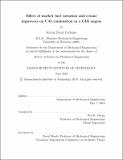Effect of market fuel variation and cetane improvers on CAI combustion in a GDI engine
Author(s)
Cedrone, Kevin David
DownloadFull printable version (2.825Mb)
Other Contributors
Massachusetts Institute of Technology. Dept. of Mechanical Engineering.
Advisor
Wai K. Cheng.
Terms of use
Metadata
Show full item recordAbstract
There is continued interest in improving the fuel conversion efficiency of internal combustion engines and simultaneously reducing their emissions. One promising technology is that of Controlled Auto Ignition (CAI) combustion. The lack of direct combustion control makes control of CAI combustion challenging. Practical implementation of CAI an engine, the engine's behavior must be predictable. This work investigates the impact of market fuel composition variation and cetane improver additives on CAI combustion in a gasoline direct injection (GDI) engine. The test fuels were blends of different commercial refinery products, containing hundreds of hydrocarbon species. The blends were selected to vary Research Octane Number (RON), olen content, and aromatic content. The blends were chosen based on a market fuel study done by the project sponsor, and subsequent research conducted at MIT. Cetane number improvers are diesel fuel additives used to shorten ignition delay in Diesel engines. Di-tert-butyl ether (DTBP) and 2-ethylhexylnitrate (2EHN) were added in concentrations of 4800ppm and 2000ppm respectively to one of the test fuels in an attempt to extend the low load limit (LLL) of CAI operation. Fuel type was found to have a modest impact on the CAI operating range. Valve timing was largely capable of compensating for the changes observed. Neither cetane additive had any significant impact on CAI operation. GDI allowed the use of a split injection strategy involving a pilot injection during negative valve overlap (NVO) recompression, before the main injection during the intake stroke. This strategy, employed at low loads, resulted in heat release during the NVO recompression, which advanced and stabilized main combustion process. At higher engine speeds, the split injection strategy resulted in lower indicated fuel conversion efficiency.
Description
Thesis (S.M.)--Massachusetts Institute of Technology, Dept. of Mechanical Engineering, 2010. This electronic version was submitted by the student author. The certified thesis is available in the Institute Archives and Special Collections. Cataloged from student-submitted PDF version of thesis. Includes bibliographical references (p. 127-129).
Date issued
2010Department
Massachusetts Institute of Technology. Department of Mechanical EngineeringPublisher
Massachusetts Institute of Technology
Keywords
Mechanical Engineering.